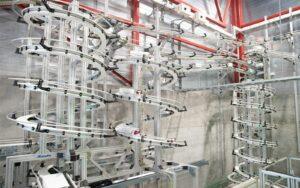Conveying System Safety Requirements
The Occupational Safety and Health Administration (OSHA) provides a set of guidelines for the operation of conveying systems. Also, the American National Standards Institute (ASNI), using the American Society of Mechanical Engineers (ASME) guidelines, has safety considerations for conveyor design.
Each year the OSHA and ASME review these requirements and update them to meet new technology and developments.
OSHA Guidelines
1926.555(a):
General requirements.
1926.555(a)(1):
A motor stoppage switch must be located at the operator position. The system should have a warning light with sound that activates when the system is turned on.
1926.555(a)(2):
Remote operations must have a stoppage switch at the motor.
1926.555(a)(3):
Emergency stop switches prevent reactivation of the system until the emergency switch is reset to “ON”.
1926.555(a)(4):
Protective coverings and protection on screw conveyors are required.
1926.555(a)(5):
Overhead conveyors must have protective coverings below the conveyor. This can be overlooked if the position of the conveyor is away from employees.
1926.555(a)(6) & 1926.555(a)(6):
Warning signs should be placed on crossovers, aisles, and passageways.
1926.555(a)(7):
Conveyors must be locked out or have warning signs during regular maintenance.
1926.555(a)(8):
Conveyors must be constructed and maintained according to ANSI B20. 1-1957 Safety Code for Conveyors, Cableways, and Related Equipment.
ASME Guidelines
The safety standards for conveyors is included in ASME B11.0-2020, which covers the safe use of machinery and includes various safety devices that should be part of the installation and construction process.
ASME B20.1-2018:
ASME B20. 1 -2018 includes the requirements for the design, construction, maintenance, and operation of a conveying system regarding hazards. It is a set of general safety guidelines. ASME B20. 1-2018 is for conveyors for industrial use and not those designed to move people.
ASME B20. 1-2018 is included in the specifications in ASME B20.1, ANSI B11.19, ANSI A1264.1, ANSI 244.1, which cover safety guidelines for conveyors and walking surfaces.
ASME B20.1 and ANSI B11.19:
These are the part of ASME B20. 1-2018 that outlines the requirements for construction, installation, maintenance, inspection, and operation of a conveying system.
ASME B20.1, ANSI B11.19, ANSI B11.0:
These are further details regarding safety procedures for permanent, temporary, and portable conveyors.
Conclusion
- Conveying systems are an essential part of automation and production.
- Each conveying system is developed to fit a specific application.
- Though belt conveying systems are the most and easily recognizable, other types include screw, pneumatic, chute, and roller.
- As with any form of machine, conveying systems require regular maintenance.
- Safety is essential with conveying systems. OSHA and ASME provide guidelines and regulations regarding the use and construction of conveying systems.





